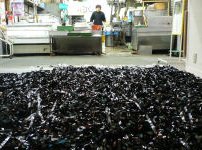普段何気なく見過ごしてしまっている自然、光、水、風、音、空気、匂いなどを作品を通すことで、そこから個々それぞれの空想の世界へと入ってもらえたら・・・。自分の作品を見て私も空想しています。<篠原 克治>
「篠原SHOW展・2」に寄せて
篠原は、「市場」という極々日常的な空間に、非日常的なオブジェそしてコンセプト―「現代アート」―を持ち込んだ。6年も前に芸術環境計画「かまぼこ」をここ阪急桜井市場に立ち上げている。慧眼の持ち主である。今回、私たちがここでギャラリーを開くことができたのは、彼の力に負うところが大きい。
現在、篠原は創作活動を続けながら、この市場で店主の一員として万全の信頼を得ている。篠原は言う。「今生きているそれが自分であり美術である」と。「かまぼこ」は、かつて篠原が仕掛けた一番大きな「パーフォーマンス」の一つではなかろうか。彼の人生観・芸術観は私が学生の頃、師事したアランカプローの言葉、“Blurring the Boundaries between Art and Life”(生活と美術の境界を曖昧にする。)を想起させる。
篠原はここ数年、使い捨てられたビデオテープを使用した観客参加型の作品を発表している。今回のインスタレーション「篠原SHOW展・2」は、「人間と自然の関係」を表す。制作過程を作品の一部とし、制作行為そのものをも芸術とみなす。あるがままの自らを美術の文脈に組み込むことにより、刻々と変化する時空間で自由な連想や即興的な行為でもって観客をもてなす。今生きているそれが自分であり美術である、と。
ビデオテープを風の通り道のようにあるいは、波のうねりのようにギャラリー空間に張り巡らし、市場に異空間を創出させる。篠原はこの空間に観客が身を投げ入れ、肌で感じることによって作品が完結すると考える。
子供を待ち構えている遊具がそうであるように、人と空間が一体となり、想像力が刺激される。風が奏でる梢のふれあう音が、木漏れ日を映し出す山肌が、せせらぎの川面のキラメキが人々の心に現出する。人々の五感を鮮やかに惑わせ、刺激することで人と場所がつながる。そこに篠原が仕組んだ「世界」がある。
篠原は、自然と人間を対立関係に据え、止揚することで観客に問題を投げかけているのだろう。かつての西洋文明では、自然は人間によって征服されるべき対象であったが、もはやそうではなくなっていることを。ただ、そこには自然へのそこはかとした郷愁がある。
ギャラリー空間を埋め尽くすのは使用済みの大量のビデオテープだ。しかし、大量消費時代の落とし子である生活廃棄物を使用することにより、篠原は、現代の社会を批判しようとしているのではない。「現状」そのものを提示しているのだ。高度経済成長期の反省に入り、自然との共生が叫ばれて久しいが、依然として、不法投棄、環境破壊、地球温暖化、などなど、人間と自然との摩擦は枚挙に暇が無い。篠原は、自然の疑似体験を通して、「自然」を希求しているのではないだろうか。しかし、これは同時に「人工の自然」の受容と捉えられる。この両義性こそが「現状」なのである。
篠原は、光り輝くものに心惹かれるという。ある日、偶然に路上に捨て去られたテープが陽光に輝く様(さま)に「美しさ」を見出した。自然の光と本来廃棄処分されるべきものをいとおしみ、めでる篠原の姿に自然と人間の共生を見て取れる。 コンテンポラリー アート ギャラリーZone 代表 中谷 徹 KATSUJI SHINOHARA`S WORK, “SHINOHARA SHOW-TEN 2”
Shinohara brought extraordinary objects and concepts―representations of contemporary art―into ordinary environments, which are ‘ichiba’ or farmer’s markets. He founded the Art Environment Program, Kamaboko, which has been in existence for six years at Hankyu Sakurai Ichiba. He is a progressive individual. And we owe him a great deal of gratitude for opening a gallery in this market. Now, he has obtained the complete trust of store keepers in this market while working as a contemporary artist. Shinohara says his life, at this minute, is an artistic performance he participates in. His view of art and life remind me of Allan Kaprow’s words, whom I studied with in my days of schooling, “Blurring the boundaries between art and life.”
Shinohara has displayed, for several years, viewer participation in works employing used videotapes. This installation, Shinohara Showten, (whose title is a pun phonetically, since Showten is the same as “shouten” in Japanese, which means a store, and he uses the English words “show” and “ten” together) represents the relationship between man and nature. He regarded the art making process itself as a part of the artistry, and yet it’s a natural action, as well. He entertains viewers with his free association of ideas and improvised action in the process of art making. It is art that I am living at this time as myself.
Videotapes are installed in the gallery, shaping the form of wind or forming the swell of a wave to create unusual space in this market. Shinohara anticipates viewers diving into the space with their skin. That is the culmination of this work. Like an amusement ride waiting for children to come it accommodates the man with the space and develops a sense of unity. The imagination is stimulated by the settings that viewers envision: listening to the twigs and leaves rustling; looking at the twinkling brook that’s filled with the sun’s reflection; projecting rays of sunlight on the face of a mountain, filtering down through the leaves. The mind and setting are connected in the imagination by stimulating the five senses. That is the world that Shinohara constructs. Shinohara is asking viewers to sublet the relations between man and nature. He believes man has united with his opposition, nature. Western civilization had been targeting nature as something to be conquered. It is not man’s nemesis anymore. Nostalgia toward nature is the sole vague remnant.
It is a large amount of used videotapes that filled the gallery space from corner to corner. However, Shinohara tries not to criticize the present society by using the industrial waste that is the aftermath of the age of mass consumption. He presented “Current state” itself. Since his reflection at the high economic growth period starts, the symbiosis with nature has been called-out. There has been illegal disposal, environmental destruction, global warming, and so on. The issues of friction between man and nature have been too many to count. Shinohara might desire “real nature” through the virtual experience of nature. However, this is captured at the same time with the acceptance of “artificial nature.” Only this ambiguity itself is “current state.”
It is said that Shinohara is attracted by something shiny. By chance, he found beauty one day in a videotape that had been discarded on the street―shining to be sunshiny. The attitude that Shinohara treasures and loves is sunlight in nature and rubbish that is disposed of intrinsically. Contemporary Art Gallery Zone director Toru Nakatani | | |







